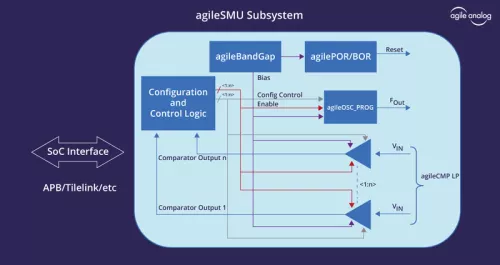The agileSMU Subsystem is a low power integrated macro consisting of the essential IP blocks required to securely manage waking up a SoC from sleep mode. Typically containing a programmable oscillator for low frequency SoC operation including a RTC, a number of low power comparators which can be used to initiate the wake-up sequence, and a power-on-reset which provides a robust, start-up reset to the SoC.
Equipped with an integrated digital controller, the agileSMU Subsystem offers precise control over wake-up commands and sequencing. Status monitors provide real-time feedback on the current state of the subsystem, ensuring optimal system performance over the full product lifecycle.
Agile Analog designs are based on tried and tested architectures to ensure reliability and functionality. Our design methodology is programmatic, systematic and repeatable leading to analog IP that is more verifiable, more robust and more reliable. Our methodology also allows us to quickly re-target our IP to different process options. We support all the major foundries including TSMC, GlobalFoundries, Samsung Foundry, Intel, and SMIC as well as other IC foundries and manufacturers. Please contact Agile Analog for further information.
Sleep Management Subsystem
Overview
Key Features
- agilePOR - Power-On-Reset
- Start-up Time: 10us
- Assertion Time: 5us (typ)
- Configurable Trigger Thresholds
- Programmable Delay
- Current consumption: 1.5uA (typ)
- agileOSC_PROG - Programmable Relaxation Oscillator
- Programmable Relaxation Oscillator
- Frequency Range: 32kHz to 20MHz
- Trimmed Accuracy: ±2%
- agileCMP_LP - Low Power Comparator
- Active Current: 1.5uA
- Programmable Detection Threshold
- Optional Hysteresis
- agileSMU Subsystem
- Industry standard digital interface
- Configurable logic to control sequencing and monitoring
- Fully integrated macro
- Standard AMBA APB interface
Block Diagram

Technical Specifications
GLOBALFOUNDRIES
Pre-Silicon:
12nm
,
14nm
,
14nm
LPE
,
14nm
LPP
,
20nm
LPM
,
22nm
,
22nm
FDX
,
28nm
,
28nm
FDSOI
,
28nm
HPP
,
28nm
LPH
,
28nm
SLP
,
32nm
,
40nm
LP
,
55nm
,
55nm
LPX
,
65nm
,
65nm
LP
,
65nm
LPe
,
90nm
,
90nm
LP
,
130nm
,
130nm
HP
,
130nm
LP
,
130nm
LV
,
180nm
,
180nm
LL
,
180nm
LL
,
180nm
LP
,
180nm
LP
Intel Foundry
Pre-Silicon:
16nm
SMIC
Pre-Silicon:
14nm
,
28nm
,
28nm
HK
,
28nm
HKC+
,
28nm
PS
,
40nm
LL
,
55nm
G
,
55nm
LL
,
65nm
LL
,
90nm
G
,
90nm
LL
,
110nm
G
,
130nm
EEPROM
,
130nm
G
,
130nm
LL
,
130nm
LV
,
150nm
G
,
150nm
LV
,
153nm
,
160nm
G
,
160nm
LL
,
180nm
EEPROM
,
180nm
G
,
180nm
LL
,
250nm
G
Samsung
Pre-Silicon:
4nm
,
5nm
,
7nm
,
8nm
,
10nm
,
11nm
,
14nm
,
28nm
FDS
,
28nm
LPH
,
28nm
LPP
TSMC
Pre-Silicon:
3nm
,
4nm
,
5nm
,
6nm
,
7nm
,
10nm
,
12nm
,
16nm
,
20nm
,
22nm
,
28nm
,
28nm
HP
,
28nm
HPC
,
28nm
HPCP
,
28nm
HPL
,
28nm
HPM
,
28nm
LP
,
40nm
G
,
40nm
LP
,
45nm
GS
,
45nm
LP
,
55nm
FL
,
55nm
G
,
55nm
GP
,
55nm
LP
,
55nm
NF
,
55nm
ULP
,
55nm
ULPEF
,
55nm
UP
,
65nm
G
,
65nm
GP
,
65nm
LP
,
80nm
,
80nm
GT
,
80nm
HS
,
85nm
,
90nm
FS
,
90nm
FT
,
90nm
G
,
90nm
GOD
,
90nm
GT
,
90nm
LP
,
90nm
zzz
,
110nm
G
,
110nm
HV
,
110nm
LVP
,
130nm
,
130nm
BCD
,
130nm
BCD+
,
130nm
G
,
130nm
LP
,
130nm
LV
,
130nm
LVOD
,
150nm
G
,
150nm
LV
,
160nm
G
,
160nm
LP
,
180nm
,
180nm
E
,
180nm
ELL
,
180nm
FG
,
180nm
G
,
180nm
LP
,
180nm
LV
,
180nm
ULL
Tower
Pre-Silicon:
130nm
,
180nm
,
180nm
,
180nm
,
500nm
UMC
Pre-Silicon:
14nm
,
22nm
,
28nm
,
28nm
HLP
,
28nm
HPC
,
28nm
HPM
,
28nm
LP
,
40nm
,
40nm
LP
,
55nm
,
65nm
LL
,
65nm
LP
,
65nm
SP
,
80nm
,
90nm
G
,
90nm
LL
,
90nm
SP
,
110nm
,
130nm
,
150nm
,
162nm
Related IPs
- Power Management Subsystem
- Controller IP, System Power/Clock Management, Soft IP
- One Port Register File Compiler IP, Bit-cell: 0.425um2 (HVT), Support retention and deep sleep modes with built-in power gating circuitry., UMC 55nm LP process
- SMIC 55nm High-Speed RVT Standard Library for Power Management Kit.
- SMIC 55nm Very-High-Speed RVT Standard Library for Power Management Kit.
- SMIC 65nm High-Density RVT Standard Library for Power Management Kit.